Primary Healthcare Nursing: Alcohol Abuse and Mental Health in Prisons
VerifiedAdded on 2019/11/08
|11
|2512
|335
Report
AI Summary
This report examines the role of primary healthcare nurses within correctional facilities, highlighting their responsibilities and the challenges they face. The report begins with an introduction to prison nursing, emphasizing the specialized nature of the field and the diverse medical needs of inmates. It then delves into the attributes required for this role, such as communication skills, emotional stability, and empathy. The report provides statistical data on the rising prison populations in Australia and the associated health issues, particularly the prevalence of mental health problems and alcohol abuse among inmates. It identifies the insufficient nursing staff as a major concern leading to inadequate care. The report discusses relevant health issues and initiatives, including the use of the 'Ottawa Charter' as a framework to address determinants of health. It outlines various initiatives such as supportive environments, prison-based rehabilitation programs, and community-strengthening projects like SPRINT. The role of primary healthcare nurses in fostering inter-sectoral collaboration and promoting positive health practices is also discussed. Finally, the report proposes two responses that PHC nurses can take to address alcohol abuse among prisoners: reorienting health services and educating prisoners, along with justifications for each response and the associated goals and objectives. The report concludes by summarizing the key findings and emphasizing the importance of primary healthcare nurses in addressing the health needs of the incarcerated population.
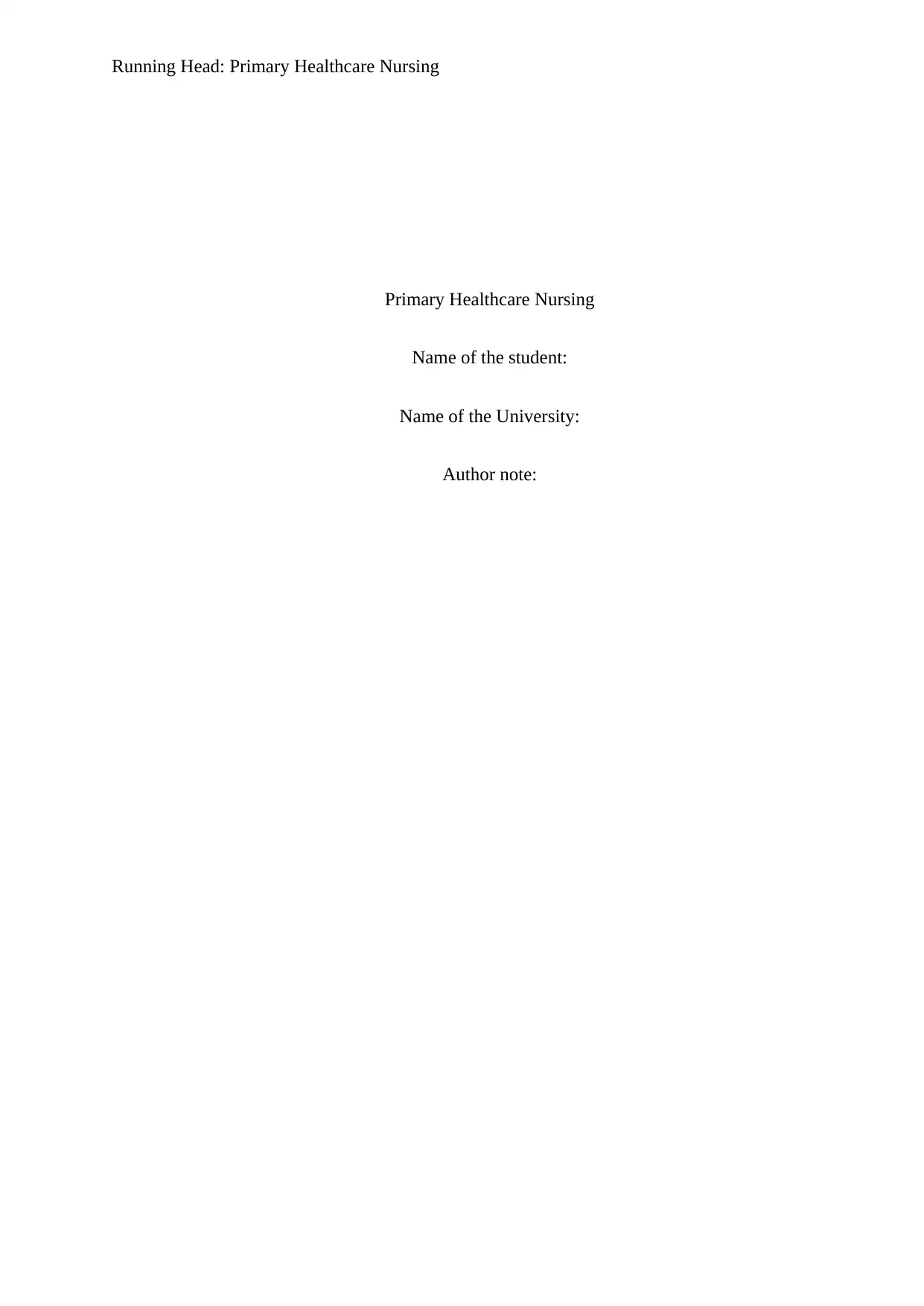
Running Head: Primary Healthcare Nursing
Primary Healthcare Nursing
Name of the student:
Name of the University:
Author note:
Primary Healthcare Nursing
Name of the student:
Name of the University:
Author note:
Paraphrase This Document
Need a fresh take? Get an instant paraphrase of this document with our AI Paraphraser
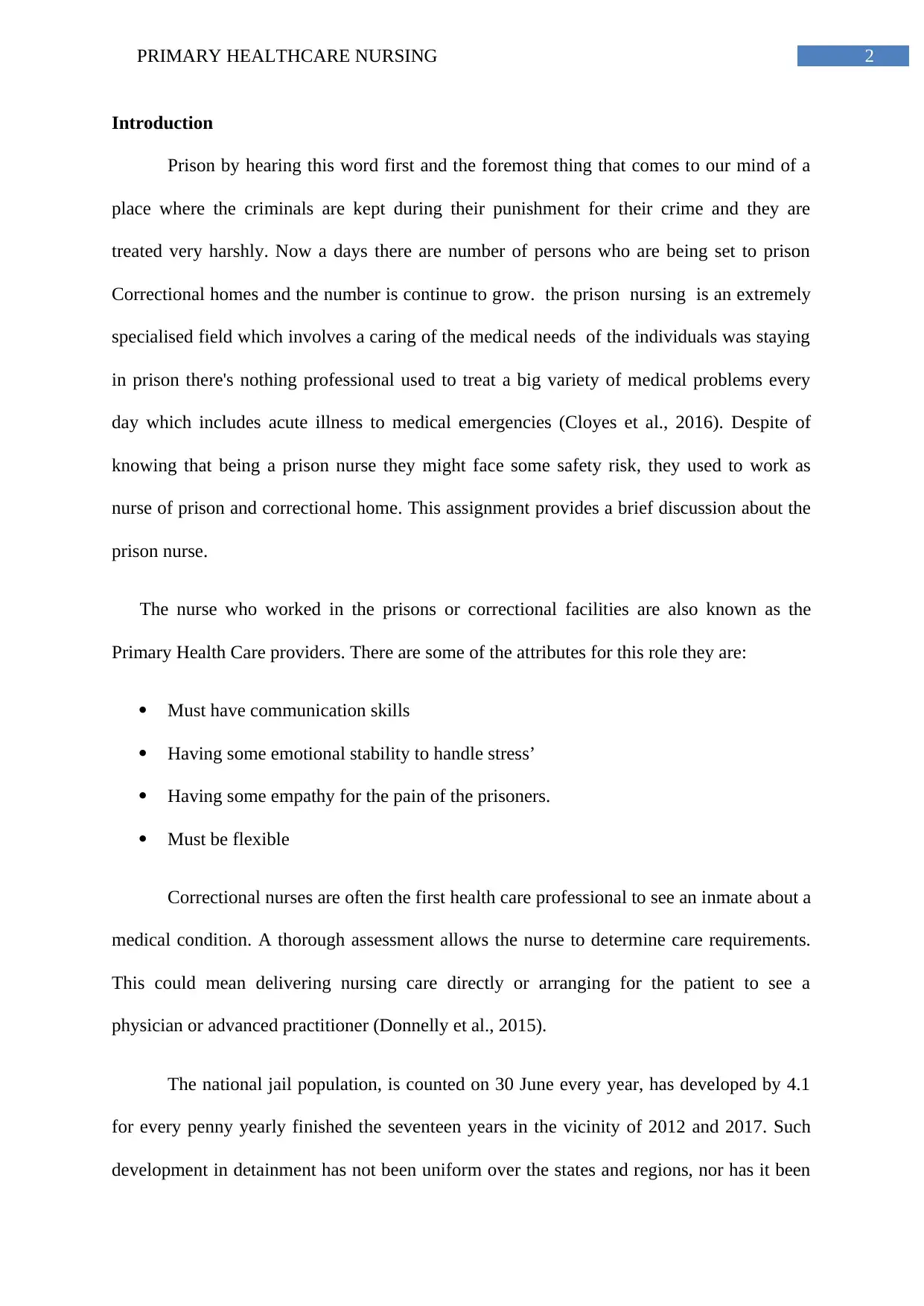
2PRIMARY HEALTHCARE NURSING
Introduction
Prison by hearing this word first and the foremost thing that comes to our mind of a
place where the criminals are kept during their punishment for their crime and they are
treated very harshly. Now a days there are number of persons who are being set to prison
Correctional homes and the number is continue to grow. the prison nursing is an extremely
specialised field which involves a caring of the medical needs of the individuals was staying
in prison there's nothing professional used to treat a big variety of medical problems every
day which includes acute illness to medical emergencies (Cloyes et al., 2016). Despite of
knowing that being a prison nurse they might face some safety risk, they used to work as
nurse of prison and correctional home. This assignment provides a brief discussion about the
prison nurse.
The nurse who worked in the prisons or correctional facilities are also known as the
Primary Health Care providers. There are some of the attributes for this role they are:
Must have communication skills
Having some emotional stability to handle stress’
Having some empathy for the pain of the prisoners.
Must be flexible
Correctional nurses are often the first health care professional to see an inmate about a
medical condition. A thorough assessment allows the nurse to determine care requirements.
This could mean delivering nursing care directly or arranging for the patient to see a
physician or advanced practitioner (Donnelly et al., 2015).
The national jail population, is counted on 30 June every year, has developed by 4.1
for every penny yearly finished the seventeen years in the vicinity of 2012 and 2017. Such
development in detainment has not been uniform over the states and regions, nor has it been
Introduction
Prison by hearing this word first and the foremost thing that comes to our mind of a
place where the criminals are kept during their punishment for their crime and they are
treated very harshly. Now a days there are number of persons who are being set to prison
Correctional homes and the number is continue to grow. the prison nursing is an extremely
specialised field which involves a caring of the medical needs of the individuals was staying
in prison there's nothing professional used to treat a big variety of medical problems every
day which includes acute illness to medical emergencies (Cloyes et al., 2016). Despite of
knowing that being a prison nurse they might face some safety risk, they used to work as
nurse of prison and correctional home. This assignment provides a brief discussion about the
prison nurse.
The nurse who worked in the prisons or correctional facilities are also known as the
Primary Health Care providers. There are some of the attributes for this role they are:
Must have communication skills
Having some emotional stability to handle stress’
Having some empathy for the pain of the prisoners.
Must be flexible
Correctional nurses are often the first health care professional to see an inmate about a
medical condition. A thorough assessment allows the nurse to determine care requirements.
This could mean delivering nursing care directly or arranging for the patient to see a
physician or advanced practitioner (Donnelly et al., 2015).
The national jail population, is counted on 30 June every year, has developed by 4.1
for every penny yearly finished the seventeen years in the vicinity of 2012 and 2017. Such
development in detainment has not been uniform over the states and regions, nor has it been
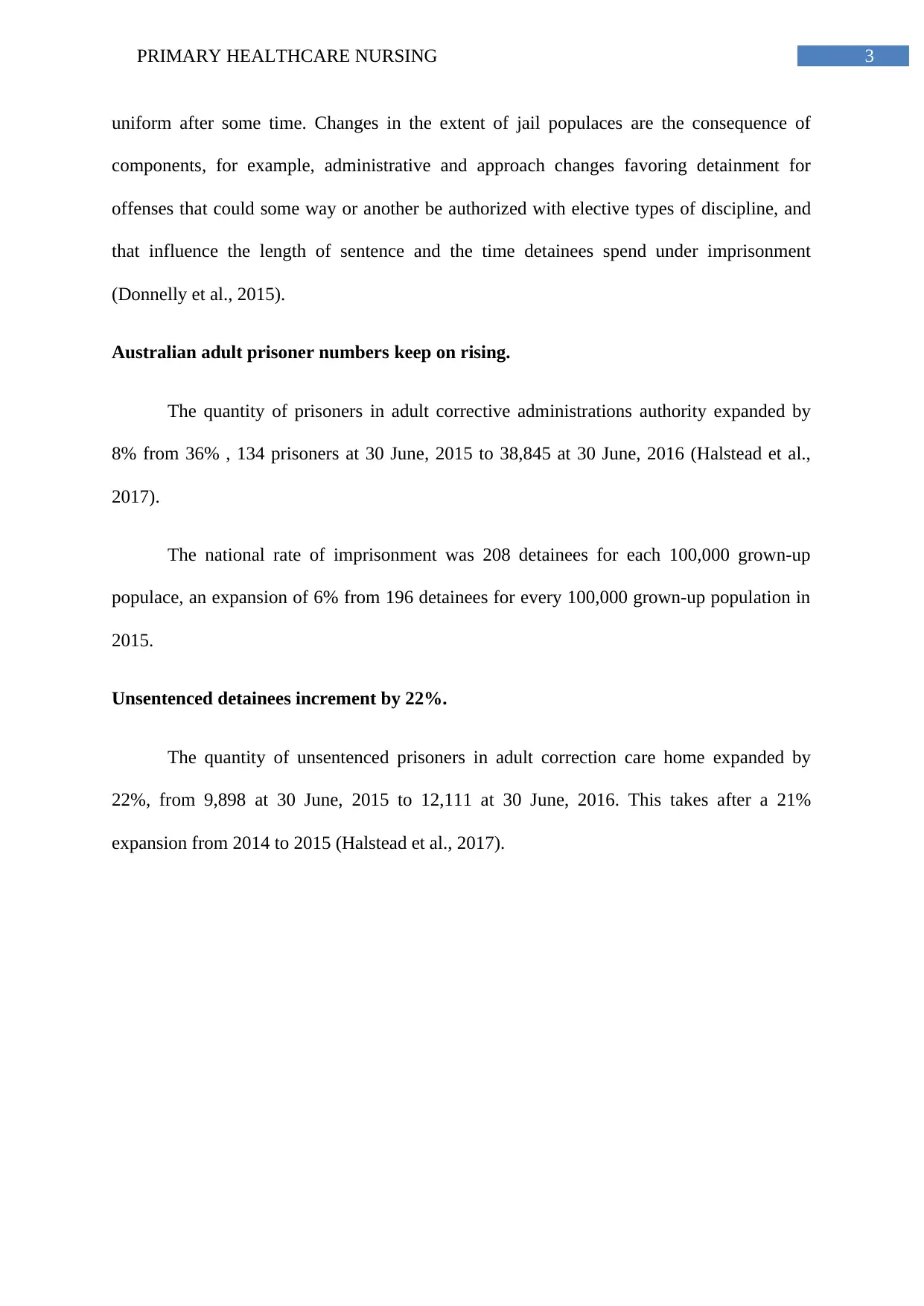
3PRIMARY HEALTHCARE NURSING
uniform after some time. Changes in the extent of jail populaces are the consequence of
components, for example, administrative and approach changes favoring detainment for
offenses that could some way or another be authorized with elective types of discipline, and
that influence the length of sentence and the time detainees spend under imprisonment
(Donnelly et al., 2015).
Australian adult prisoner numbers keep on rising.
The quantity of prisoners in adult corrective administrations authority expanded by
8% from 36% , 134 prisoners at 30 June, 2015 to 38,845 at 30 June, 2016 (Halstead et al.,
2017).
The national rate of imprisonment was 208 detainees for each 100,000 grown-up
populace, an expansion of 6% from 196 detainees for every 100,000 grown-up population in
2015.
Unsentenced detainees increment by 22%.
The quantity of unsentenced prisoners in adult correction care home expanded by
22%, from 9,898 at 30 June, 2015 to 12,111 at 30 June, 2016. This takes after a 21%
expansion from 2014 to 2015 (Halstead et al., 2017).
uniform after some time. Changes in the extent of jail populaces are the consequence of
components, for example, administrative and approach changes favoring detainment for
offenses that could some way or another be authorized with elective types of discipline, and
that influence the length of sentence and the time detainees spend under imprisonment
(Donnelly et al., 2015).
Australian adult prisoner numbers keep on rising.
The quantity of prisoners in adult corrective administrations authority expanded by
8% from 36% , 134 prisoners at 30 June, 2015 to 38,845 at 30 June, 2016 (Halstead et al.,
2017).
The national rate of imprisonment was 208 detainees for each 100,000 grown-up
populace, an expansion of 6% from 196 detainees for every 100,000 grown-up population in
2015.
Unsentenced detainees increment by 22%.
The quantity of unsentenced prisoners in adult correction care home expanded by
22%, from 9,898 at 30 June, 2015 to 12,111 at 30 June, 2016. This takes after a 21%
expansion from 2014 to 2015 (Halstead et al., 2017).
⊘ This is a preview!⊘
Do you want full access?
Subscribe today to unlock all pages.

Trusted by 1+ million students worldwide
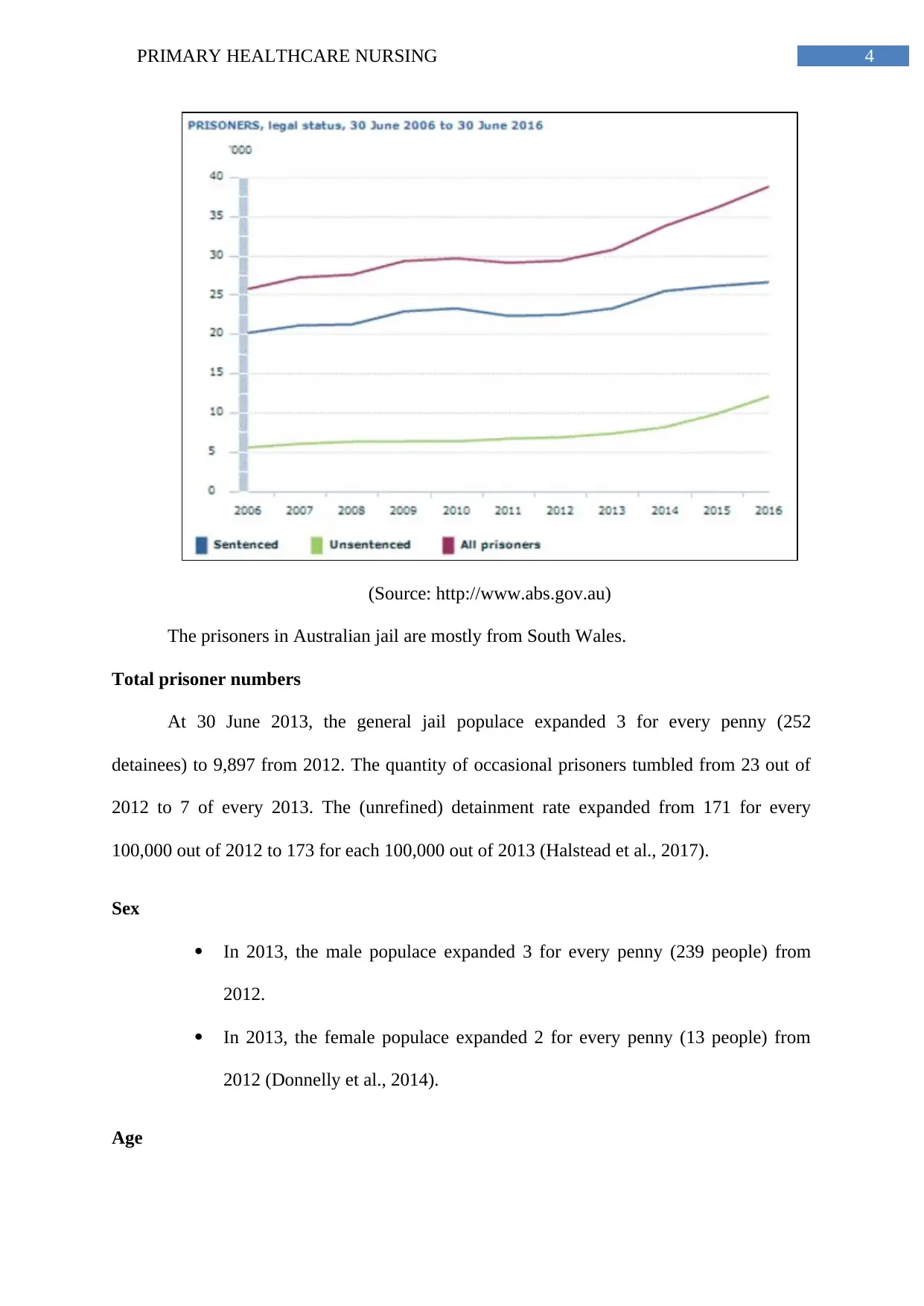
4PRIMARY HEALTHCARE NURSING
(Source: http://www.abs.gov.au)
The prisoners in Australian jail are mostly from South Wales.
Total prisoner numbers
At 30 June 2013, the general jail populace expanded 3 for every penny (252
detainees) to 9,897 from 2012. The quantity of occasional prisoners tumbled from 23 out of
2012 to 7 of every 2013. The (unrefined) detainment rate expanded from 171 for every
100,000 out of 2012 to 173 for each 100,000 out of 2013 (Halstead et al., 2017).
Sex
In 2013, the male populace expanded 3 for every penny (239 people) from
2012.
In 2013, the female populace expanded 2 for every penny (13 people) from
2012 (Donnelly et al., 2014).
Age
(Source: http://www.abs.gov.au)
The prisoners in Australian jail are mostly from South Wales.
Total prisoner numbers
At 30 June 2013, the general jail populace expanded 3 for every penny (252
detainees) to 9,897 from 2012. The quantity of occasional prisoners tumbled from 23 out of
2012 to 7 of every 2013. The (unrefined) detainment rate expanded from 171 for every
100,000 out of 2012 to 173 for each 100,000 out of 2013 (Halstead et al., 2017).
Sex
In 2013, the male populace expanded 3 for every penny (239 people) from
2012.
In 2013, the female populace expanded 2 for every penny (13 people) from
2012 (Donnelly et al., 2014).
Age
Paraphrase This Document
Need a fresh take? Get an instant paraphrase of this document with our AI Paraphraser
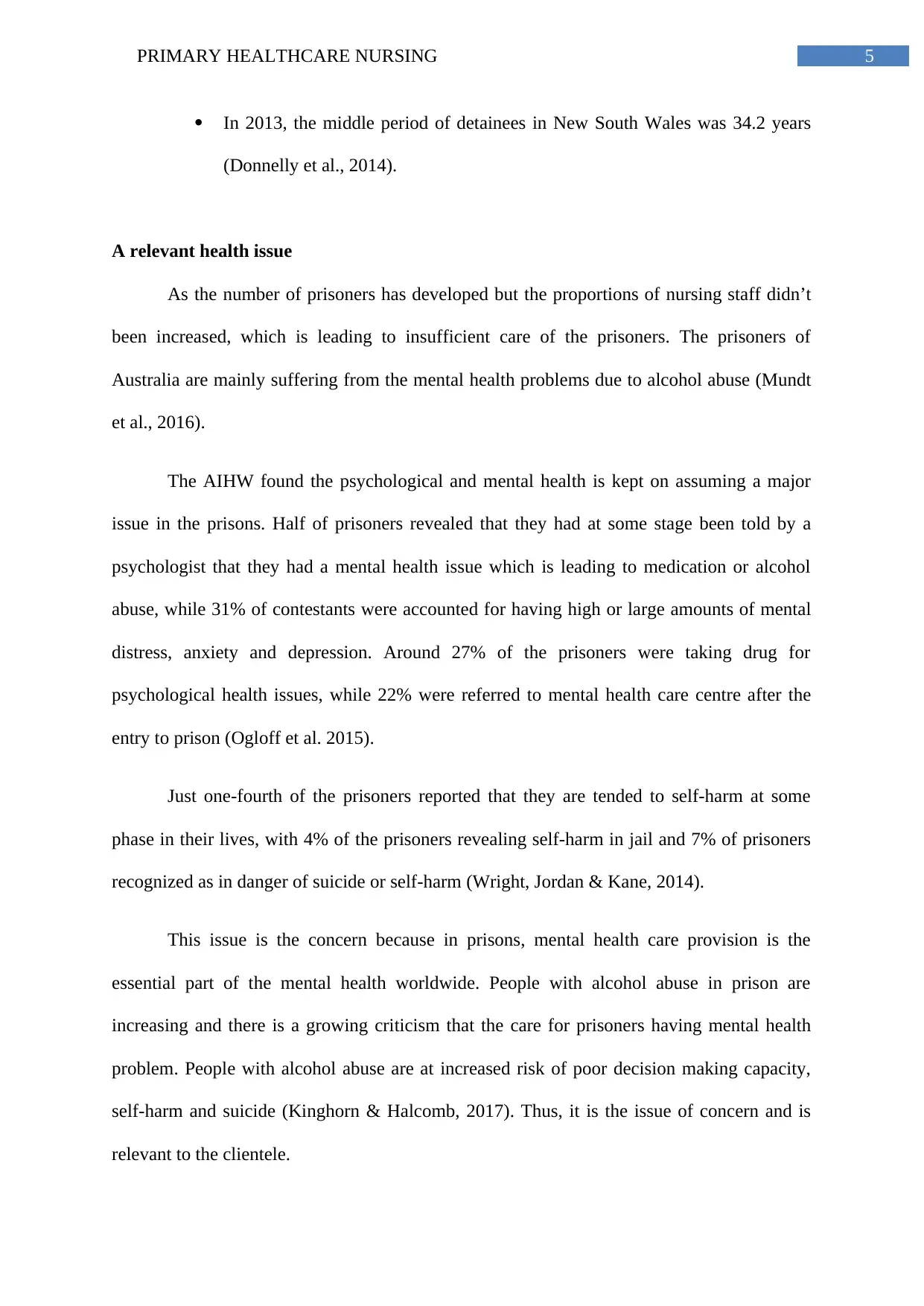
5PRIMARY HEALTHCARE NURSING
In 2013, the middle period of detainees in New South Wales was 34.2 years
(Donnelly et al., 2014).
A relevant health issue
As the number of prisoners has developed but the proportions of nursing staff didn’t
been increased, which is leading to insufficient care of the prisoners. The prisoners of
Australia are mainly suffering from the mental health problems due to alcohol abuse (Mundt
et al., 2016).
The AIHW found the psychological and mental health is kept on assuming a major
issue in the prisons. Half of prisoners revealed that they had at some stage been told by a
psychologist that they had a mental health issue which is leading to medication or alcohol
abuse, while 31% of contestants were accounted for having high or large amounts of mental
distress, anxiety and depression. Around 27% of the prisoners were taking drug for
psychological health issues, while 22% were referred to mental health care centre after the
entry to prison (Ogloff et al. 2015).
Just one-fourth of the prisoners reported that they are tended to self-harm at some
phase in their lives, with 4% of the prisoners revealing self-harm in jail and 7% of prisoners
recognized as in danger of suicide or self-harm (Wright, Jordan & Kane, 2014).
This issue is the concern because in prisons, mental health care provision is the
essential part of the mental health worldwide. People with alcohol abuse in prison are
increasing and there is a growing criticism that the care for prisoners having mental health
problem. People with alcohol abuse are at increased risk of poor decision making capacity,
self-harm and suicide (Kinghorn & Halcomb, 2017). Thus, it is the issue of concern and is
relevant to the clientele.
In 2013, the middle period of detainees in New South Wales was 34.2 years
(Donnelly et al., 2014).
A relevant health issue
As the number of prisoners has developed but the proportions of nursing staff didn’t
been increased, which is leading to insufficient care of the prisoners. The prisoners of
Australia are mainly suffering from the mental health problems due to alcohol abuse (Mundt
et al., 2016).
The AIHW found the psychological and mental health is kept on assuming a major
issue in the prisons. Half of prisoners revealed that they had at some stage been told by a
psychologist that they had a mental health issue which is leading to medication or alcohol
abuse, while 31% of contestants were accounted for having high or large amounts of mental
distress, anxiety and depression. Around 27% of the prisoners were taking drug for
psychological health issues, while 22% were referred to mental health care centre after the
entry to prison (Ogloff et al. 2015).
Just one-fourth of the prisoners reported that they are tended to self-harm at some
phase in their lives, with 4% of the prisoners revealing self-harm in jail and 7% of prisoners
recognized as in danger of suicide or self-harm (Wright, Jordan & Kane, 2014).
This issue is the concern because in prisons, mental health care provision is the
essential part of the mental health worldwide. People with alcohol abuse in prison are
increasing and there is a growing criticism that the care for prisoners having mental health
problem. People with alcohol abuse are at increased risk of poor decision making capacity,
self-harm and suicide (Kinghorn & Halcomb, 2017). Thus, it is the issue of concern and is
relevant to the clientele.
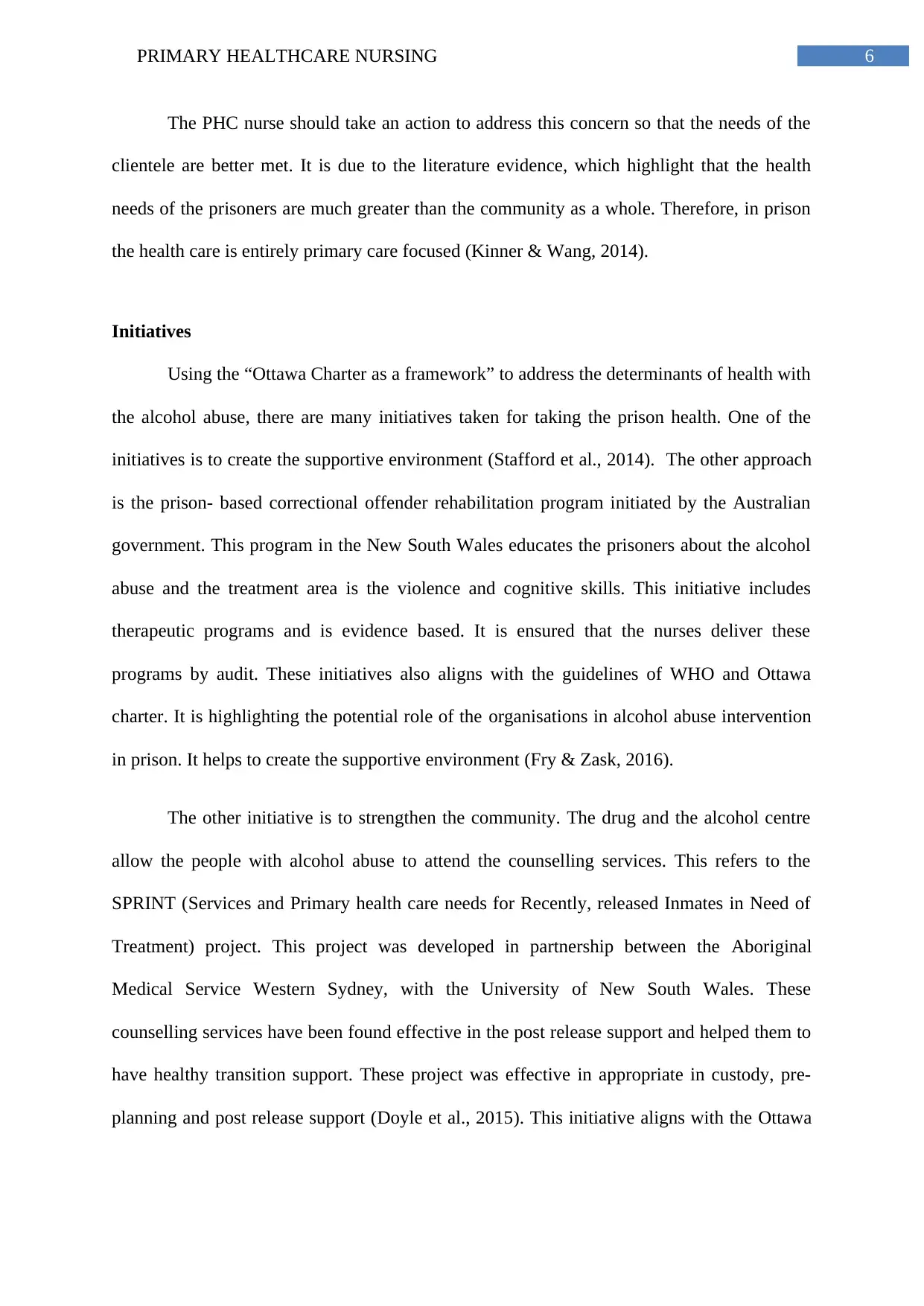
6PRIMARY HEALTHCARE NURSING
The PHC nurse should take an action to address this concern so that the needs of the
clientele are better met. It is due to the literature evidence, which highlight that the health
needs of the prisoners are much greater than the community as a whole. Therefore, in prison
the health care is entirely primary care focused (Kinner & Wang, 2014).
Initiatives
Using the “Ottawa Charter as a framework” to address the determinants of health with
the alcohol abuse, there are many initiatives taken for taking the prison health. One of the
initiatives is to create the supportive environment (Stafford et al., 2014). The other approach
is the prison- based correctional offender rehabilitation program initiated by the Australian
government. This program in the New South Wales educates the prisoners about the alcohol
abuse and the treatment area is the violence and cognitive skills. This initiative includes
therapeutic programs and is evidence based. It is ensured that the nurses deliver these
programs by audit. These initiatives also aligns with the guidelines of WHO and Ottawa
charter. It is highlighting the potential role of the organisations in alcohol abuse intervention
in prison. It helps to create the supportive environment (Fry & Zask, 2016).
The other initiative is to strengthen the community. The drug and the alcohol centre
allow the people with alcohol abuse to attend the counselling services. This refers to the
SPRINT (Services and Primary health care needs for Recently, released Inmates in Need of
Treatment) project. This project was developed in partnership between the Aboriginal
Medical Service Western Sydney, with the University of New South Wales. These
counselling services have been found effective in the post release support and helped them to
have healthy transition support. These project was effective in appropriate in custody, pre-
planning and post release support (Doyle et al., 2015). This initiative aligns with the Ottawa
The PHC nurse should take an action to address this concern so that the needs of the
clientele are better met. It is due to the literature evidence, which highlight that the health
needs of the prisoners are much greater than the community as a whole. Therefore, in prison
the health care is entirely primary care focused (Kinner & Wang, 2014).
Initiatives
Using the “Ottawa Charter as a framework” to address the determinants of health with
the alcohol abuse, there are many initiatives taken for taking the prison health. One of the
initiatives is to create the supportive environment (Stafford et al., 2014). The other approach
is the prison- based correctional offender rehabilitation program initiated by the Australian
government. This program in the New South Wales educates the prisoners about the alcohol
abuse and the treatment area is the violence and cognitive skills. This initiative includes
therapeutic programs and is evidence based. It is ensured that the nurses deliver these
programs by audit. These initiatives also aligns with the guidelines of WHO and Ottawa
charter. It is highlighting the potential role of the organisations in alcohol abuse intervention
in prison. It helps to create the supportive environment (Fry & Zask, 2016).
The other initiative is to strengthen the community. The drug and the alcohol centre
allow the people with alcohol abuse to attend the counselling services. This refers to the
SPRINT (Services and Primary health care needs for Recently, released Inmates in Need of
Treatment) project. This project was developed in partnership between the Aboriginal
Medical Service Western Sydney, with the University of New South Wales. These
counselling services have been found effective in the post release support and helped them to
have healthy transition support. These project was effective in appropriate in custody, pre-
planning and post release support (Doyle et al., 2015). This initiative aligns with the Ottawa
⊘ This is a preview!⊘
Do you want full access?
Subscribe today to unlock all pages.

Trusted by 1+ million students worldwide
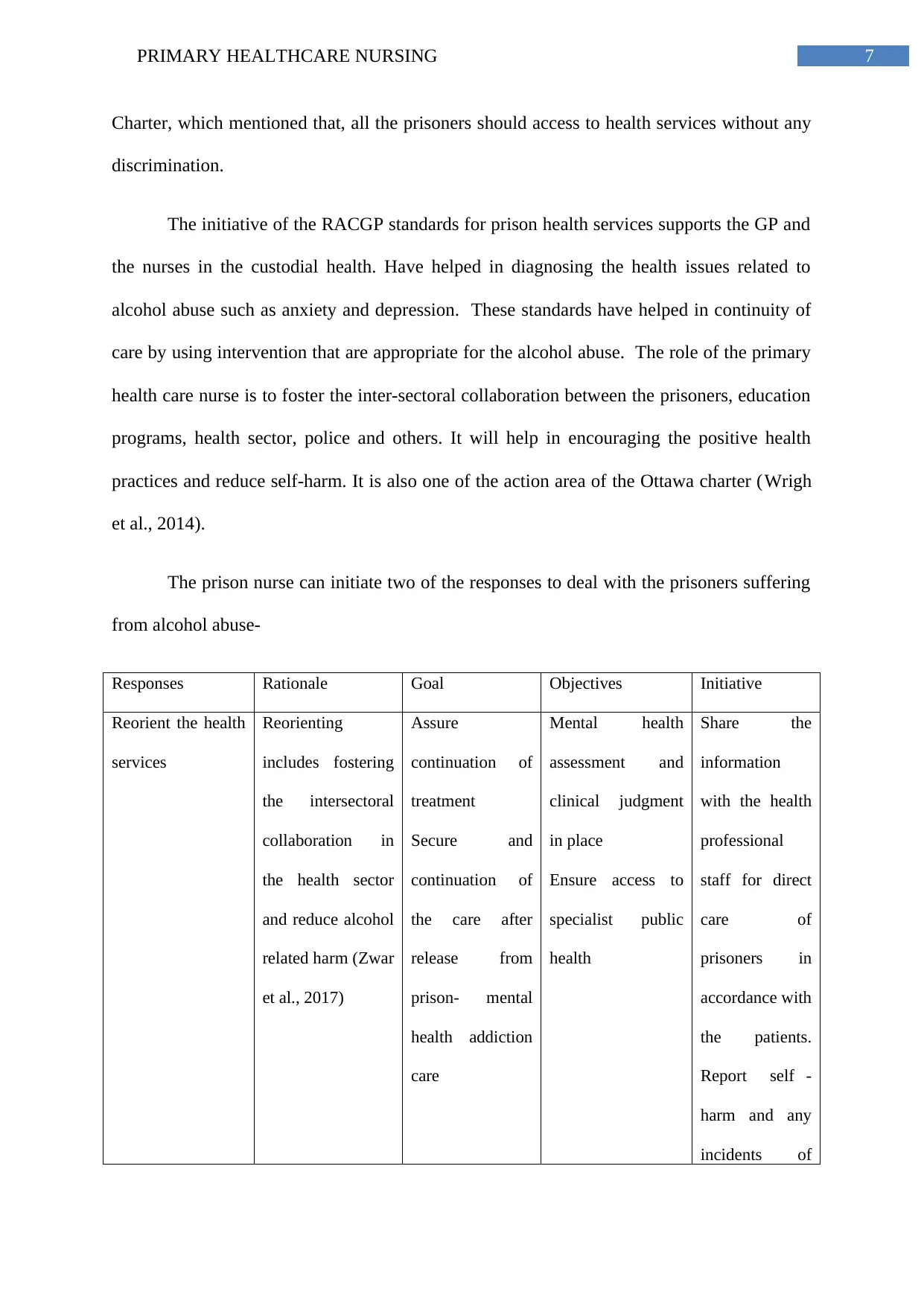
7PRIMARY HEALTHCARE NURSING
Charter, which mentioned that, all the prisoners should access to health services without any
discrimination.
The initiative of the RACGP standards for prison health services supports the GP and
the nurses in the custodial health. Have helped in diagnosing the health issues related to
alcohol abuse such as anxiety and depression. These standards have helped in continuity of
care by using intervention that are appropriate for the alcohol abuse. The role of the primary
health care nurse is to foster the inter-sectoral collaboration between the prisoners, education
programs, health sector, police and others. It will help in encouraging the positive health
practices and reduce self-harm. It is also one of the action area of the Ottawa charter (Wrigh
et al., 2014).
The prison nurse can initiate two of the responses to deal with the prisoners suffering
from alcohol abuse-
Responses Rationale Goal Objectives Initiative
Reorient the health
services
Reorienting
includes fostering
the intersectoral
collaboration in
the health sector
and reduce alcohol
related harm (Zwar
et al., 2017)
Assure
continuation of
treatment
Secure and
continuation of
the care after
release from
prison- mental
health addiction
care
Mental health
assessment and
clinical judgment
in place
Ensure access to
specialist public
health
Share the
information
with the health
professional
staff for direct
care of
prisoners in
accordance with
the patients.
Report self -
harm and any
incidents of
Charter, which mentioned that, all the prisoners should access to health services without any
discrimination.
The initiative of the RACGP standards for prison health services supports the GP and
the nurses in the custodial health. Have helped in diagnosing the health issues related to
alcohol abuse such as anxiety and depression. These standards have helped in continuity of
care by using intervention that are appropriate for the alcohol abuse. The role of the primary
health care nurse is to foster the inter-sectoral collaboration between the prisoners, education
programs, health sector, police and others. It will help in encouraging the positive health
practices and reduce self-harm. It is also one of the action area of the Ottawa charter (Wrigh
et al., 2014).
The prison nurse can initiate two of the responses to deal with the prisoners suffering
from alcohol abuse-
Responses Rationale Goal Objectives Initiative
Reorient the health
services
Reorienting
includes fostering
the intersectoral
collaboration in
the health sector
and reduce alcohol
related harm (Zwar
et al., 2017)
Assure
continuation of
treatment
Secure and
continuation of
the care after
release from
prison- mental
health addiction
care
Mental health
assessment and
clinical judgment
in place
Ensure access to
specialist public
health
Share the
information
with the health
professional
staff for direct
care of
prisoners in
accordance with
the patients.
Report self -
harm and any
incidents of
Paraphrase This Document
Need a fresh take? Get an instant paraphrase of this document with our AI Paraphraser
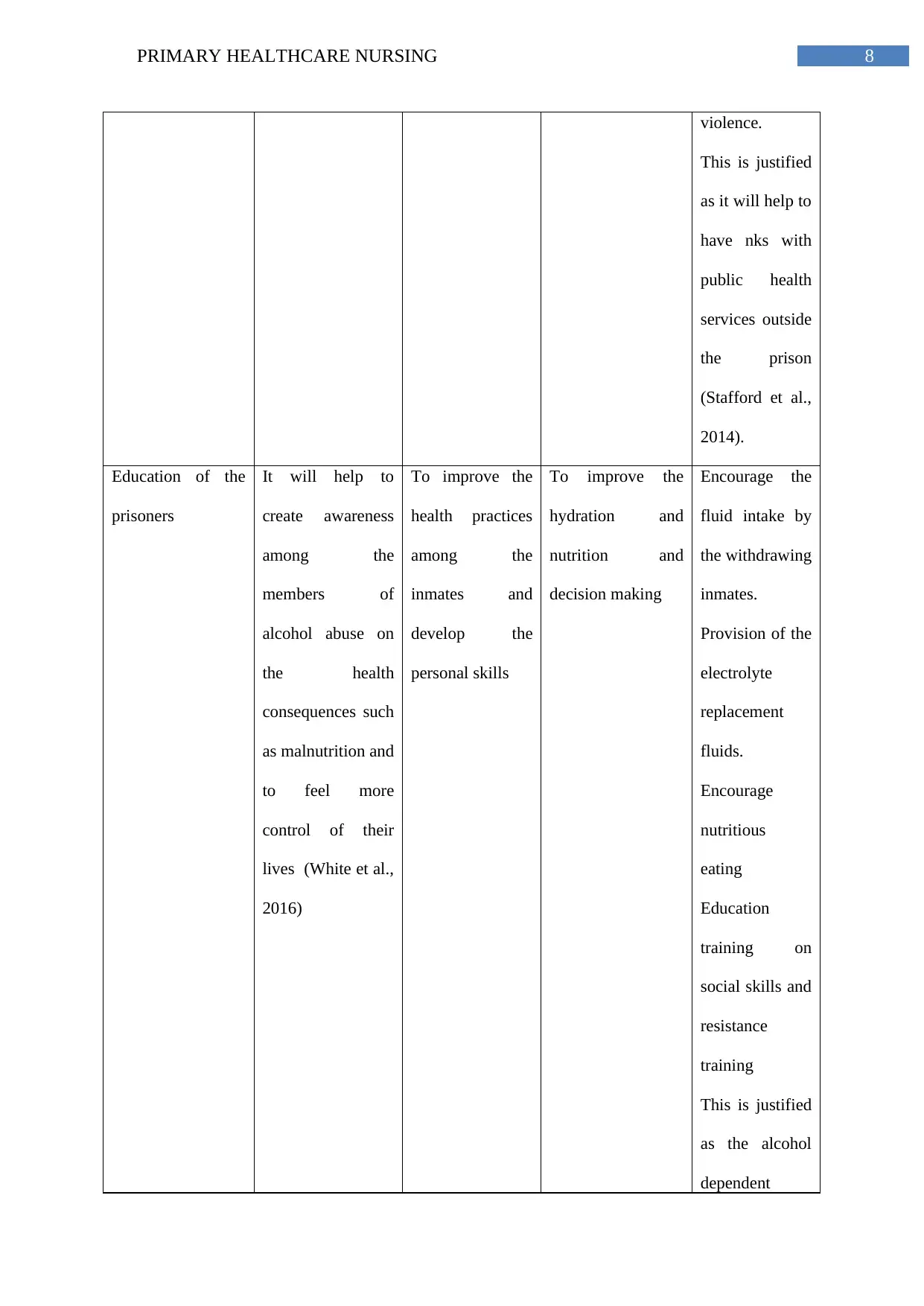
8PRIMARY HEALTHCARE NURSING
violence.
This is justified
as it will help to
have nks with
public health
services outside
the prison
(Stafford et al.,
2014).
Education of the
prisoners
It will help to
create awareness
among the
members of
alcohol abuse on
the health
consequences such
as malnutrition and
to feel more
control of their
lives (White et al.,
2016)
To improve the
health practices
among the
inmates and
develop the
personal skills
To improve the
hydration and
nutrition and
decision making
Encourage the
fluid intake by
the withdrawing
inmates.
Provision of the
electrolyte
replacement
fluids.
Encourage
nutritious
eating
Education
training on
social skills and
resistance
training
This is justified
as the alcohol
dependent
violence.
This is justified
as it will help to
have nks with
public health
services outside
the prison
(Stafford et al.,
2014).
Education of the
prisoners
It will help to
create awareness
among the
members of
alcohol abuse on
the health
consequences such
as malnutrition and
to feel more
control of their
lives (White et al.,
2016)
To improve the
health practices
among the
inmates and
develop the
personal skills
To improve the
hydration and
nutrition and
decision making
Encourage the
fluid intake by
the withdrawing
inmates.
Provision of the
electrolyte
replacement
fluids.
Encourage
nutritious
eating
Education
training on
social skills and
resistance
training
This is justified
as the alcohol
dependent
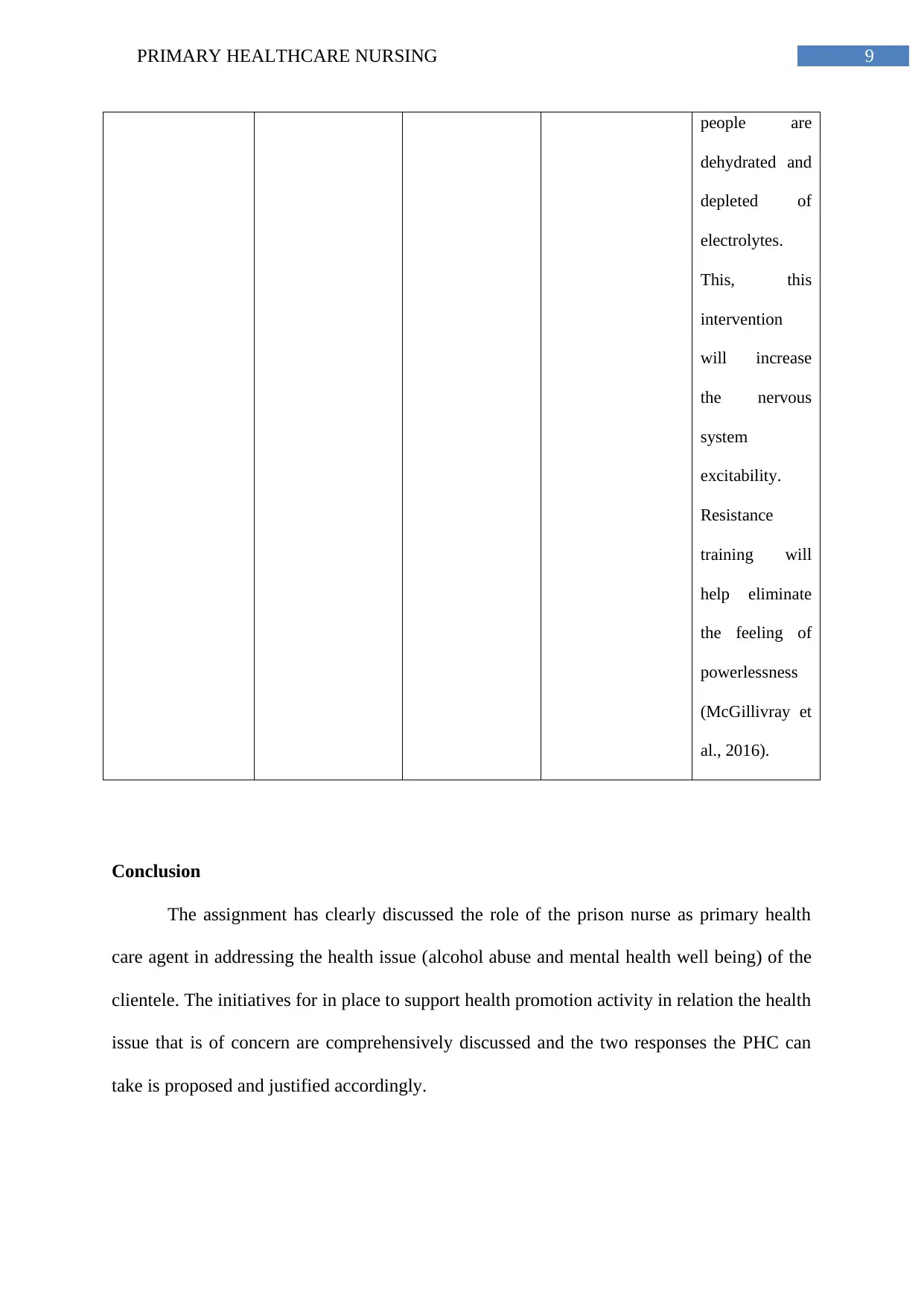
9PRIMARY HEALTHCARE NURSING
people are
dehydrated and
depleted of
electrolytes.
This, this
intervention
will increase
the nervous
system
excitability.
Resistance
training will
help eliminate
the feeling of
powerlessness
(McGillivray et
al., 2016).
Conclusion
The assignment has clearly discussed the role of the prison nurse as primary health
care agent in addressing the health issue (alcohol abuse and mental health well being) of the
clientele. The initiatives for in place to support health promotion activity in relation the health
issue that is of concern are comprehensively discussed and the two responses the PHC can
take is proposed and justified accordingly.
people are
dehydrated and
depleted of
electrolytes.
This, this
intervention
will increase
the nervous
system
excitability.
Resistance
training will
help eliminate
the feeling of
powerlessness
(McGillivray et
al., 2016).
Conclusion
The assignment has clearly discussed the role of the prison nurse as primary health
care agent in addressing the health issue (alcohol abuse and mental health well being) of the
clientele. The initiatives for in place to support health promotion activity in relation the health
issue that is of concern are comprehensively discussed and the two responses the PHC can
take is proposed and justified accordingly.
⊘ This is a preview!⊘
Do you want full access?
Subscribe today to unlock all pages.

Trusted by 1+ million students worldwide
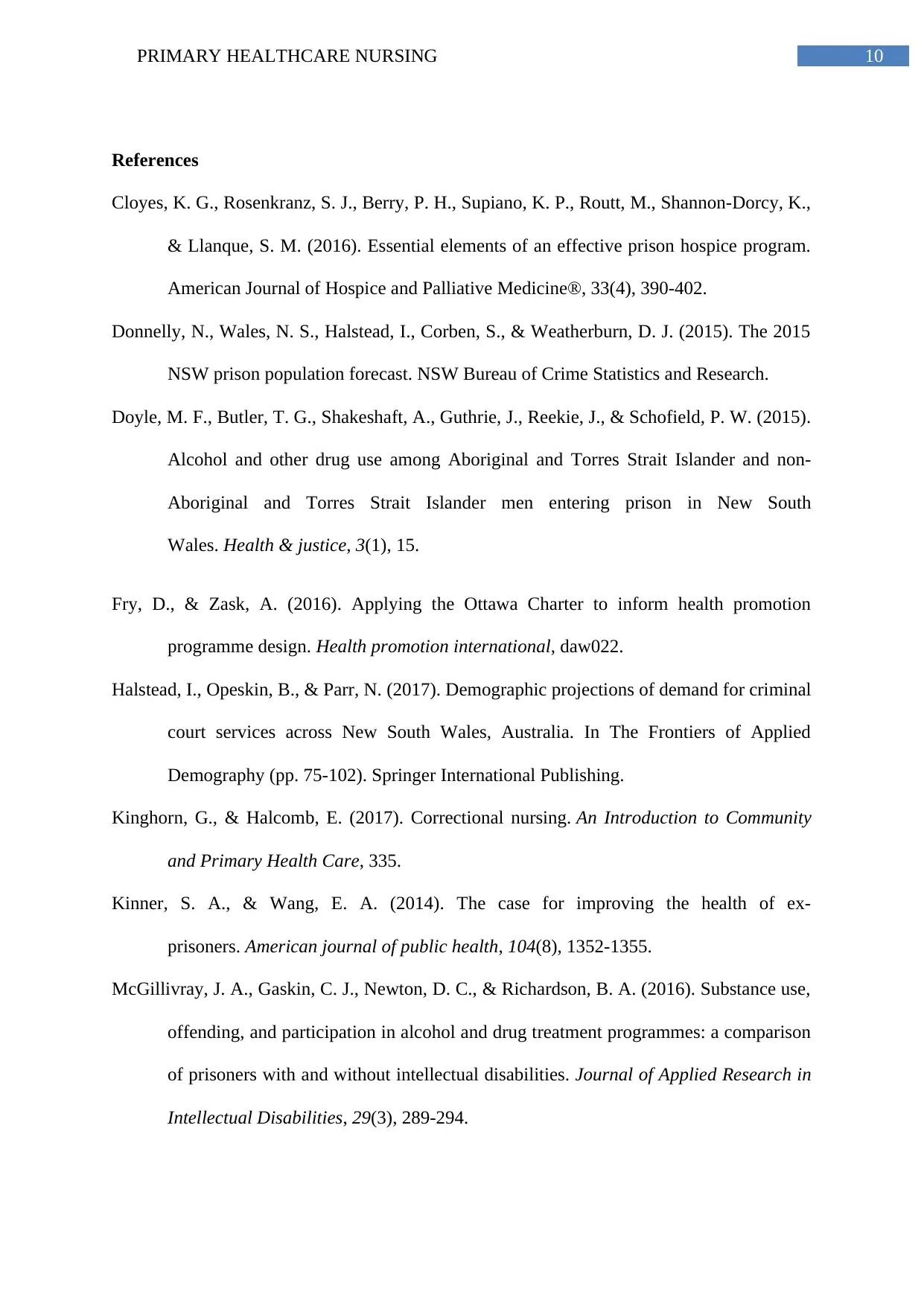
10PRIMARY HEALTHCARE NURSING
References
Cloyes, K. G., Rosenkranz, S. J., Berry, P. H., Supiano, K. P., Routt, M., Shannon-Dorcy, K.,
& Llanque, S. M. (2016). Essential elements of an effective prison hospice program.
American Journal of Hospice and Palliative Medicine®, 33(4), 390-402.
Donnelly, N., Wales, N. S., Halstead, I., Corben, S., & Weatherburn, D. J. (2015). The 2015
NSW prison population forecast. NSW Bureau of Crime Statistics and Research.
Doyle, M. F., Butler, T. G., Shakeshaft, A., Guthrie, J., Reekie, J., & Schofield, P. W. (2015).
Alcohol and other drug use among Aboriginal and Torres Strait Islander and non-
Aboriginal and Torres Strait Islander men entering prison in New South
Wales. Health & justice, 3(1), 15.
Fry, D., & Zask, A. (2016). Applying the Ottawa Charter to inform health promotion
programme design. Health promotion international, daw022.
Halstead, I., Opeskin, B., & Parr, N. (2017). Demographic projections of demand for criminal
court services across New South Wales, Australia. In The Frontiers of Applied
Demography (pp. 75-102). Springer International Publishing.
Kinghorn, G., & Halcomb, E. (2017). Correctional nursing. An Introduction to Community
and Primary Health Care, 335.
Kinner, S. A., & Wang, E. A. (2014). The case for improving the health of ex-
prisoners. American journal of public health, 104(8), 1352-1355.
McGillivray, J. A., Gaskin, C. J., Newton, D. C., & Richardson, B. A. (2016). Substance use,
offending, and participation in alcohol and drug treatment programmes: a comparison
of prisoners with and without intellectual disabilities. Journal of Applied Research in
Intellectual Disabilities, 29(3), 289-294.
References
Cloyes, K. G., Rosenkranz, S. J., Berry, P. H., Supiano, K. P., Routt, M., Shannon-Dorcy, K.,
& Llanque, S. M. (2016). Essential elements of an effective prison hospice program.
American Journal of Hospice and Palliative Medicine®, 33(4), 390-402.
Donnelly, N., Wales, N. S., Halstead, I., Corben, S., & Weatherburn, D. J. (2015). The 2015
NSW prison population forecast. NSW Bureau of Crime Statistics and Research.
Doyle, M. F., Butler, T. G., Shakeshaft, A., Guthrie, J., Reekie, J., & Schofield, P. W. (2015).
Alcohol and other drug use among Aboriginal and Torres Strait Islander and non-
Aboriginal and Torres Strait Islander men entering prison in New South
Wales. Health & justice, 3(1), 15.
Fry, D., & Zask, A. (2016). Applying the Ottawa Charter to inform health promotion
programme design. Health promotion international, daw022.
Halstead, I., Opeskin, B., & Parr, N. (2017). Demographic projections of demand for criminal
court services across New South Wales, Australia. In The Frontiers of Applied
Demography (pp. 75-102). Springer International Publishing.
Kinghorn, G., & Halcomb, E. (2017). Correctional nursing. An Introduction to Community
and Primary Health Care, 335.
Kinner, S. A., & Wang, E. A. (2014). The case for improving the health of ex-
prisoners. American journal of public health, 104(8), 1352-1355.
McGillivray, J. A., Gaskin, C. J., Newton, D. C., & Richardson, B. A. (2016). Substance use,
offending, and participation in alcohol and drug treatment programmes: a comparison
of prisoners with and without intellectual disabilities. Journal of Applied Research in
Intellectual Disabilities, 29(3), 289-294.
Paraphrase This Document
Need a fresh take? Get an instant paraphrase of this document with our AI Paraphraser
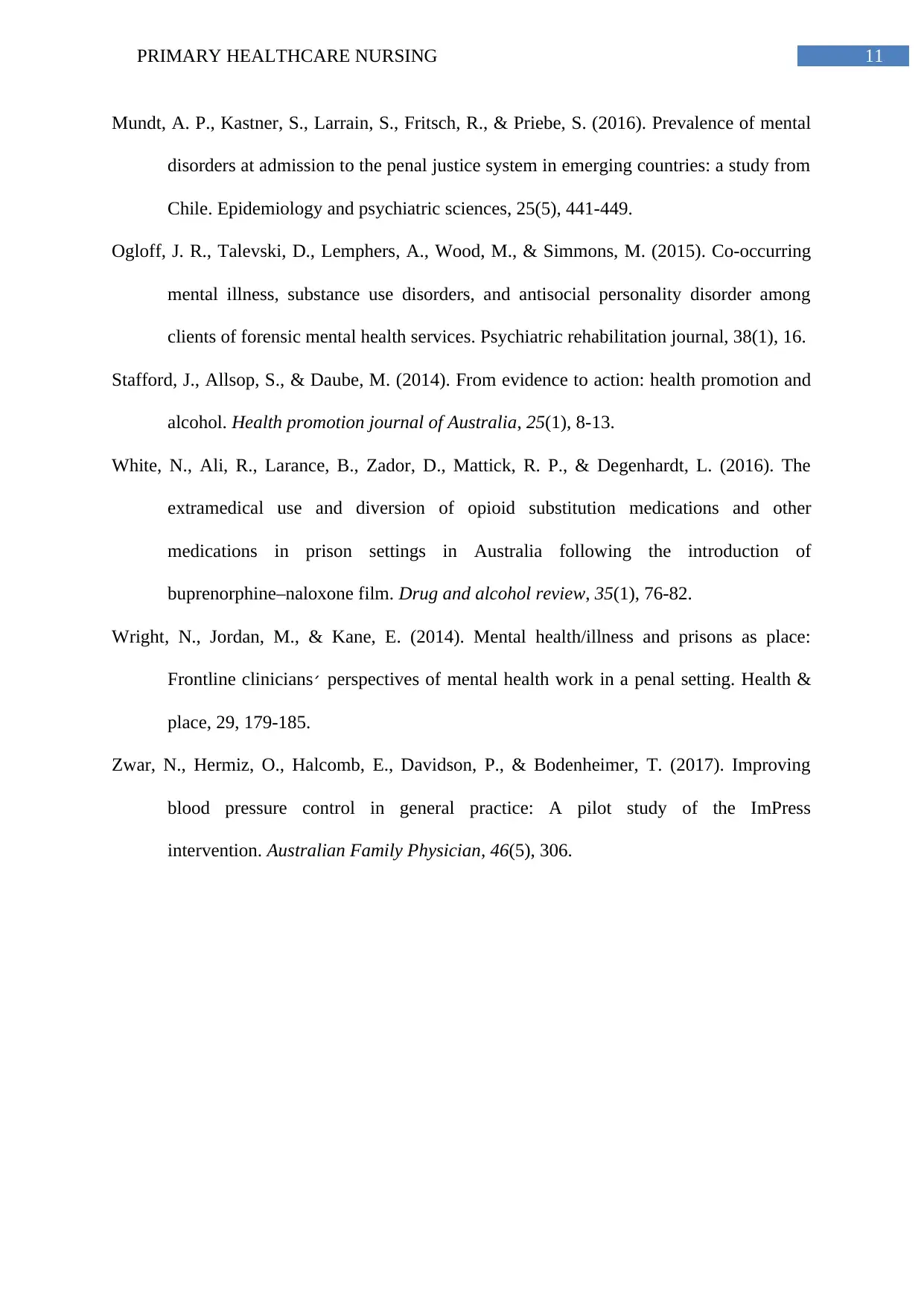
11PRIMARY HEALTHCARE NURSING
Mundt, A. P., Kastner, S., Larrain, S., Fritsch, R., & Priebe, S. (2016). Prevalence of mental
disorders at admission to the penal justice system in emerging countries: a study from
Chile. Epidemiology and psychiatric sciences, 25(5), 441-449.
Ogloff, J. R., Talevski, D., Lemphers, A., Wood, M., & Simmons, M. (2015). Co-occurring
mental illness, substance use disorders, and antisocial personality disorder among
clients of forensic mental health services. Psychiatric rehabilitation journal, 38(1), 16.
Stafford, J., Allsop, S., & Daube, M. (2014). From evidence to action: health promotion and
alcohol. Health promotion journal of Australia, 25(1), 8-13.
White, N., Ali, R., Larance, B., Zador, D., Mattick, R. P., & Degenhardt, L. (2016). The
extramedical use and diversion of opioid substitution medications and other
medications in prison settings in Australia following the introduction of
buprenorphine–naloxone film. Drug and alcohol review, 35(1), 76-82.
Wright, N., Jordan, M., & Kane, E. (2014). Mental health/illness and prisons as place:
Frontline clinicians׳ perspectives of mental health work in a penal setting. Health &
place, 29, 179-185.
Zwar, N., Hermiz, O., Halcomb, E., Davidson, P., & Bodenheimer, T. (2017). Improving
blood pressure control in general practice: A pilot study of the ImPress
intervention. Australian Family Physician, 46(5), 306.
Mundt, A. P., Kastner, S., Larrain, S., Fritsch, R., & Priebe, S. (2016). Prevalence of mental
disorders at admission to the penal justice system in emerging countries: a study from
Chile. Epidemiology and psychiatric sciences, 25(5), 441-449.
Ogloff, J. R., Talevski, D., Lemphers, A., Wood, M., & Simmons, M. (2015). Co-occurring
mental illness, substance use disorders, and antisocial personality disorder among
clients of forensic mental health services. Psychiatric rehabilitation journal, 38(1), 16.
Stafford, J., Allsop, S., & Daube, M. (2014). From evidence to action: health promotion and
alcohol. Health promotion journal of Australia, 25(1), 8-13.
White, N., Ali, R., Larance, B., Zador, D., Mattick, R. P., & Degenhardt, L. (2016). The
extramedical use and diversion of opioid substitution medications and other
medications in prison settings in Australia following the introduction of
buprenorphine–naloxone film. Drug and alcohol review, 35(1), 76-82.
Wright, N., Jordan, M., & Kane, E. (2014). Mental health/illness and prisons as place:
Frontline clinicians׳ perspectives of mental health work in a penal setting. Health &
place, 29, 179-185.
Zwar, N., Hermiz, O., Halcomb, E., Davidson, P., & Bodenheimer, T. (2017). Improving
blood pressure control in general practice: A pilot study of the ImPress
intervention. Australian Family Physician, 46(5), 306.
1 out of 11
Your All-in-One AI-Powered Toolkit for Academic Success.
+13062052269
info@desklib.com
Available 24*7 on WhatsApp / Email
![[object Object]](/_next/static/media/star-bottom.7253800d.svg)
Unlock your academic potential
Copyright © 2020–2025 A2Z Services. All Rights Reserved. Developed and managed by ZUCOL.